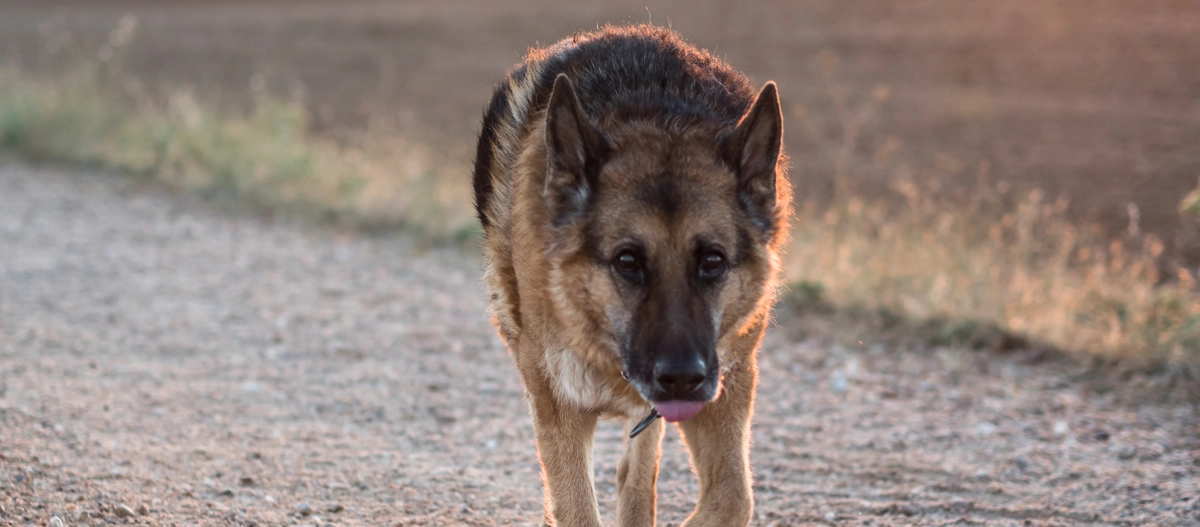Intervertebral disc herniations also occur in dogs. Many small breeds such as Dachshunds or French Bulldogs are commonly affected. The faster you act, the lower the risk of irreversible damage. Therefore, it is important to know what an intervertebral disc herniation is, what symptoms to look for, and what to do when they occur.
Intervertebral Disc Herniation: What is it?
The spinal cord of the dog runs similarly to that of humans from the first cervical vertebra to the lumbar area and transports information from the brain to the body and vice versa. It is responsible, among other things, for triggering and controlling movements and reflexes, healthy digestion, breathing, and the motor function of the legs and trunk. The spine protects the spinal cord like a coat. Between the individual vertebrae of the spine are the intervertebral discs. These are ring-shaped, elastic discs that act as shock-absorbing binding elements. Without them, the vertebral bones would interlock and block each other. Intervertebral discs thus ensure smooth and resilient mobility of the spine. At the same time, they also contribute to protecting the spinal cord.
An intervertebral disc consists of two layers:
- Nucleus pulposus: the soft gel core inside
- Anulus fibrosus: the outer, firm fibrous ring that encloses the core and holds the intervertebral disc in position
In a dog with an intervertebral disc herniation – also called discopathy or disc prolapse – there is either a rupture of the outer ring, causing the almost liquid core to protrude (Type 1); this leads to compression of the spinal cord and narrowing of the nerve tissue. Or the fibrous ring gradually softens, causing the core to bulge more and more with the ring (Type 2). This is usually a slower process than with Type 1.

Recognizing Intervertebral Disc Herniation in Dogs – Symptoms
The symptoms of your four-legged friend depend heavily on the severity and affected region. There are five grades of the condition: Generally, the first sign is a more or less pronounced sensitivity of the spine, often accompanied by reduced urge to move. In severe cases, there are neurological deficits. These range from numbness in the legs to complete paralysis. Fecal and urinary incontinence are also included here. Another indication may be an unnatural back or neck posture – depending on whether the intervertebral disc herniation is in the cervical, thoracic, or lumbar region.
Diagnosis and Treatment
If there is suspicion of an intervertebral disc herniation, seek a veterinarian as soon as possible. Restrain your dog and limit its movement. Do not let him climb stairs or jump, if possible. Also, using a chest harness instead of a collar can be relieving.
The veterinarian usually starts with a general examination to rule out other causes such as inflammation, tumors, or vertebral fractures. This is followed by the neurological examination. This includes an MRI, a CT scan, and contrast radiography: A substance is injected to make the constriction in the spinal cord visible on the X-ray. Since these measures can only be carried out under general anesthesia, a preliminary examination is also important to spare the dog this risk and stress if there is another finding for his symptoms.
In mild cases of intervertebral disc herniation without signs of paralysis, conservative therapy without surgery is usually employed. It consists of taking painkillers, possibly also anti-inflammatories, and above all, absolute rest for at least one week. Playing, interacting with other dogs, and climbing stairs are strictly prohibited. During walks, only take short walks on a leash and make sure the dog does not move too freely in the house. It is better to rest your dog for a few weeks longer than to risk a relapse due to too early or too intense activity. Physiotherapy also supports the healing process and strengthens the tissue.

In severe cases with signs of paralysis or when conservative therapy fails, surgery is unavoidable to prevent irreversible damage. After surgery, physiotherapy is necessary to help the muscles learn to function properly again and restore sensitivity. This may include exercises such as standing training and, once the dog is able to stand again, therapy on an underwater treadmill.
The costs of surgery vary greatly depending on the individual patient and can reach into the four-figure range. Additionally, postoperative care must be taken into account.
Causes
The most common causes of intervertebral disc herniation in dogs include:
- Breed predispositions (especially common in small dogs with short legs and long backs, such as Dachshunds or French Bulldogs)
- Overweight and lack of exercise
- Overuse and improper loading
- Age-related wear and tear
- Injuries and accidents
Prevention
If you want to actively prevent a possible intervertebral disc herniation, focus on maintaining balanced exercise and nutrition for your dog. Strengthen the back muscles with targeted exercises such as canine gymnastics. Breed-appropriate dog sports are not only beneficial for health, but also enjoyable for both human and animal, strengthening your bond through shared training.


